If You Are Good Enough For War, You Are Good Enough To Vote, Cartoon (1917)
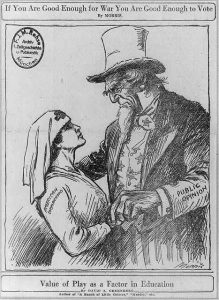
If You Are Good Enough For War, You Are Good Enough To Vote is a cartoon created by William C. Morris and was featured in a 1917 edition of The Brooklyn Magazine. The cartoon depicts Uncle Sam holding a U.S. army female nurse and is symbolic of America embracing women as full citizens. The United States were still involved in World War I at the time. However the women’s suffrage movement was put on hold. Prior to the war, feminist leaders had an agreement with Woodrow Wilson to stop protesting in front of the White House. In return President Wilson promised to push for the 19th Amendment- allowing women the right to vote, after the conclusion of the war. This way the U.S. could appear as a united defender of democracy and women could become full citizens. The cartoon does a great job mobilizing many Americans to stand behind woman’s suffrage post WWI leading to the ratification of the 19th Amendment in 1920. It was able to do so by allowing people to understand that if women were willing to sacrifice their lives and their momentum for suffrage, then America should repay women by making them full democratic participants.
Hello Girls, Photo, 1919
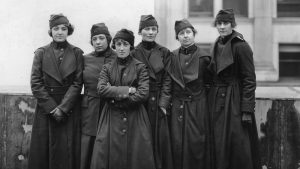
This is a photo of a group of “Hello Girls” preparing to depart for France in 1919 in the midst of WWI. Hello Girls, or switchboard operators, were recruited to serve overseas due to their ability to speak english and french fluently. Once overseas they would help translate messages between english and french speaking troops. While serving, Hello Girls wore the same uniform, received the same wages, and the same badges as their male counterparts. Thus giving women their first taste of equality. Hello Girls, became upset when they returned to the U.S. and were exposed to gender inequalities once again. However, thanks to WWI they were able to use their newfound skills in order to get jobs as secretaries and phone operators. Women started joining the work force and abandoning the the traditional role of a stay at home women. This was the start of women’s economic independence, which evolved into social independence and equality.
The Negro Has Always Wanted the Four Freedoms, Essay (1944)
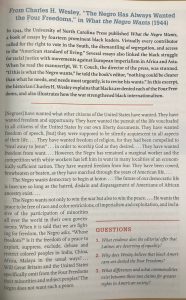
“The Negro Has Always Wanted the Four Freedoms” is an essay written by Charles Wesley in 1944. It is in direct response to Franklin D. Roosevelt’s “Four Freedoms” Speech during his 1941 inauguration. In this speech, FDR declared that after WWII the world will have freedom of speech, freedom of religion, freedom from want, and freedom from fear. However many black Americans were deprived of the very freedoms they were fighting and dying for. Wesley, in his essay, showed the juxtaposition of black soldiers dying for democracy, all the while their brothers and sisters were being lynched at home. The hypocrisy of FDR’s speech led many black Americans to become more active in the fight for civil rights and equality in the form of a Double V Campaign. The Double V Campaign was the declaration of many black Americans to fight for democracy at home as well as abroad. During this time, membership of the NAACP increased from 50,000 to 500,000, hundreds of thousands black citizens migrated north in search of industrial jobs, and protests began to proliferate. These budding acts of protest eventually grew into the modern civil rights movement of the 1960’s.
When Communism Takes over All is Destroyed, Image, 1950’s
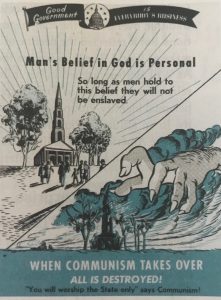
“When Communism Takes over All is Destroyed” was included in a booklet created by the American Economic Foundation in the 1950’s. This image represents the forming of the religious right. America’s religious population was filtering out of politics because they felt as if both parties had abandoned religious ideals. However by the 1950’s more and more religious Americans began to join the Republican Party because they were the party taking a strong stance against communism. The Religious Right was fearful that if communism was to spread globally, then religion would become extinct. This fear is represented in the photo by the hand of communism reaching out to destroy and church and its parishioners. The photo, and other red scare tactics, inspired many Christians, who otherwise were politically silent, to become politically involved and back the Republican Party.
Port Huron Statement, Manifesto (1962)
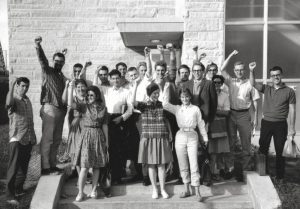
The Port Huron Statement was the manifesto for the group, Students for a Democratic Society (SDS), and was published June 15, 1962. The Port Huron Statement is SDS’s way of notifying America, specifically America’s youth, that there is a more liberal New Left. The New Left is separating itself from the traditional left and Democratic Party in hopes of having more progressive policy. The SDS found success in recruiting young Americans who were tired of the traditional establishment and disillusionment of the government. Many members felt as if the U.S. government was not listening to their democratic voices when it decided to become involved in Vietnam. Therefore SDS chapters spread to many colleges across the nation. SDS inspired many students to become politically involved. As SDS grew members starting demanding more liberal policy such as civil rights legislation and women’s equality. SDS’s fight for a true democratic process helped put an end to the draft and reduce the voting age to eighteen.
The Casualties of War in Vietnam, Speech (1967)
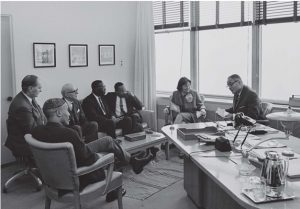
On February 25, 1967 Martin Luther King Jr., along with anti-war congress members, spoke out against the Vietnam War at a symposium in California. In his speech titled “The Casualties of War in Vietnam,” he spoke about the continued mistreatment of black civilians. In this instance MLK highlights the unequal appropriation of congressional funds distributed between the Vietnam War and domestic social welfare programs. Black Americans were too focused on gaining democracy for themselves that they were uninterested in becoming involved in any foreign conflict under the premise of “defending democracy.” Yet they were still being drafted at disproportional rates compared to the white population of America. Therefore MLK wants to connect the anti-war effort and civil rights movement in hopes of getting more support for both social movements. He is thus able to garner more support for the civil rights movement through his anti-war stance and by identifying continued mistreatment of the very people that are fighting for America. Civil rights mobilization ramped up leading to increased protests, demands for equality, and eventually the Voting Rights Act of 1965.
The Vietnam Song, Song, 1969
Country Joe and The Fish performed “The Vietnam Song” in 1969 at the Woodstock Music Festival in Bethel, New York. The festival occurred in the midst of the counterculture revolution. Anti-war protests were very prevalent at the time of Woodstock. Musicians, such as Country Joe and the Fish, decided to included acts of protest in their set list. “The Vietnam Song” references how students are abandoning their books in order to pick up guns. A reoccurring refrain is “What are we fighting for? Don’t ask me I don’t give a damn…We’re all gonna die!” These lyrics were intended to symbolize the carelessness of the U.S. government when it came to sending Americans to fight in Vietnam. The musicians however, were not the only protesters. The festival grounds were breeding grounds for many young counterculture hippies to meet political activists. America thus saw a proliferation of young anti-war protesters and political activists that otherwise would be politically silent had the U.S. not gone to war with Vietnam. These protestors mobilized in opposition to the war but evolved into demanding equal rights for LGTBTQ+, women, and people of color.
Draft Card Burning, Photo, June 20, 1969
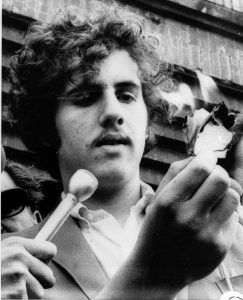
This is a photo of Ken Love burning his draft card in 1969. Draft card burning was a very common protest among draft-eligible men who were in opposition to the war and the draft. Burning one’s draft card was criminalized after the 1968 Court decision of The United States v. O’Brien ruled that this form of protest was not protected under the free speech clause of the First Amendment. However people, primarily young males, continued to hold draft card burnings as a peaceful way to protest. By 1973 the Selective Service declared that there would no longer be a draft for future U.S. wars. This was a major victory for anti-war protesters and democracy. Removal of the draft can be accredited to the millions of young protesters who became politically engaged in opposition to the Vietnam War. Protests were not limited to draft card burnings. They also took the shape of sit-ins, marches, black arm bands, just to name a few.
The Challenge of Peace, Letter (1983)
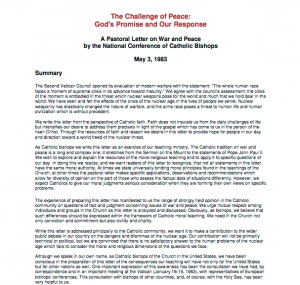
American Bishops wrote the “Challenge of Peace” in 1983 to address President Reagan’s plan to revamp the nuclear race with the U.S.S.R. The Catholic Church was removed from American politics before the Cold War. However fear of a nuclear war that would kill millions of innocents influenced American Bishops to become politically involved. The letter called for a return to the détente and a reduction of America’s nuclear arsenal. Reagan’s refusal to change his foreign policy led many Catholic members of the “religious right” to abandon the Republican Party and protest against Reagan and nuclear armament.
Interview With Code Pink co-Founder Jodie Evans, Interview (2005)
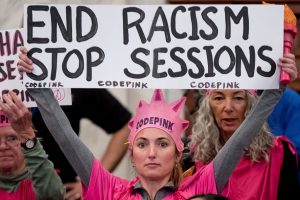
This Interview between Sharon Groves and Code Pink member, Jodie Evans, took place on March 1, 2005. The interview provides insight on Code Pink’s mission and how they were able to mobilize into a successful organization. Code Pink was originally an organization that protested the Iraq War. Today they have thousands of members that support causes such as women’s rights, religious freedoms, and more progressive policy. Code Pink was able to grow into the organization it is today due to the Iraq War. Opposition to the Iraq War and the War on Terror, which suspended many constitutional rights, influenced the founding members to mobilize. Now Code Pink has attended every Republic and Democratic National Convention since 2004, members are actively engaged in both domestic and foreign politics, and there is a political platform for women who want to become involved.
Obama Ends, ‘Don’t Ask Don’t Tell’ Policy, Newspaper Article, July 22, 2011
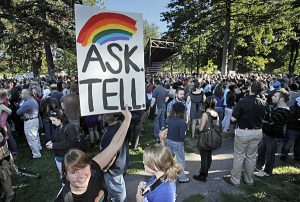
This article, written by Elisabeth Bumiller, reports on President Obama’s decision to repeal the “Don’t Ask Don’t Tell” policy enacted by President Clinton in 1933. The policy stated that homosexuals could serve in the U.S. Military as long as they kept their sexual orientation hidden. Thousands of enrolled service members were discharged for violating the policy. Many LGBTQ activists and allies protested the inequality, believing that any person should be allowed to serve in the Military freely, no matter their sexual preference. In July of 2011, after mass protests, Obama announced that he had signed off on a repeal bill that would end the prejudice toward LGBTQ service members. However, since same sex marriage was not legal in every state, LGBTQ veterans would not receive the same benefits, such as housing, health insurance, and death benefits for their partners. People continued to protest for this continued inequality. They made the same case for LGBTQ service members as people did for women and black troops; if they are willing to sacrifice for democracy abroad, then they should have democracy at home. These protests helped garner support for legalized same court marriage up until the Supreme Court made it legal in 2015.
